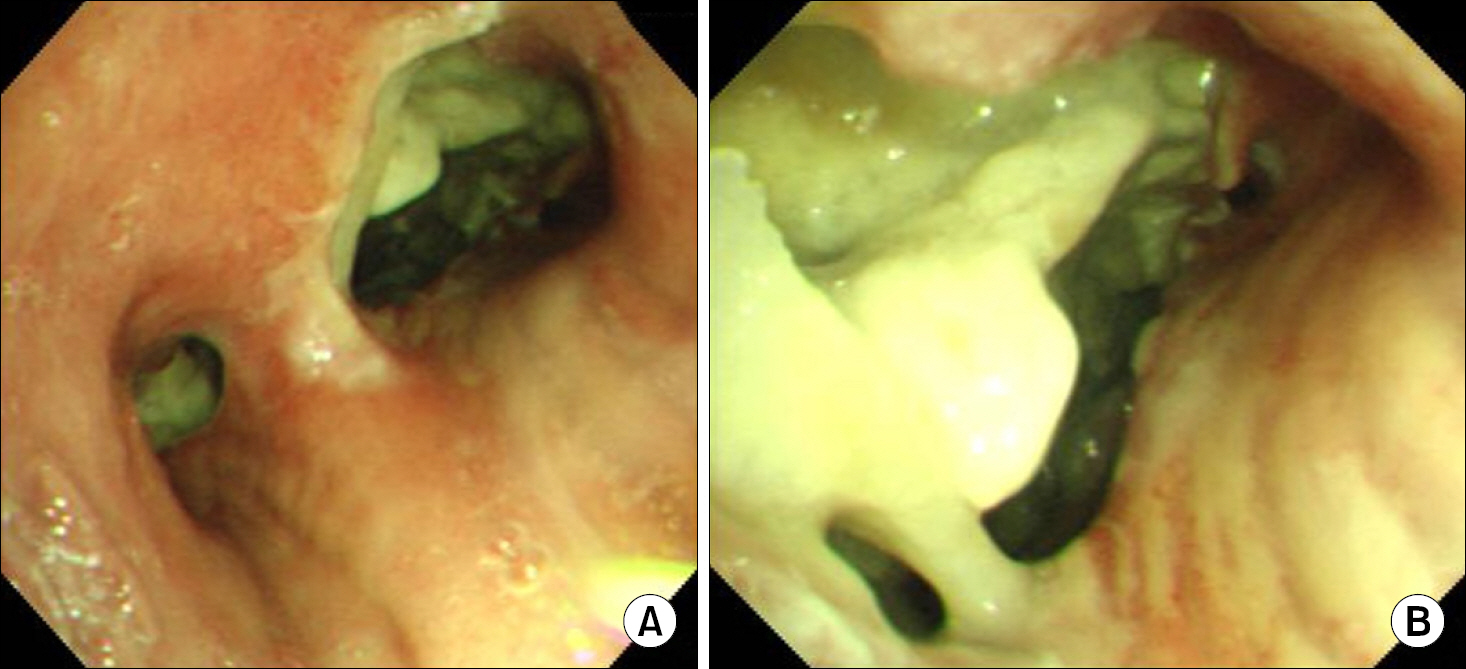J Lung Cancer.
2011 Dec;10(2):102-104. 10.6058/jlc.2011.10.2.102.
Fatal Broncho-Mediastinal Fistula in a Patient with Non-Small Cell Lung Cancer after Photodynamic Therapy
- Affiliations
-
- 1Department of Internal Medicine, SMG-SNU Boramae Medical Center, Seoul, Korea.
- 2Division of Hematology and Medical Oncology, Department of Internal Medicine, Seoul National University of Bundang Hospital, Seongnam, Korea.
- 3Division of Pulmonary and Critical Care Medicine, Department of Internal Medicine and Lung Institute, Seoul National University College of Medicine, Seoul, Korea. scyang@snu.ac.kr
- KMID: 2005741
- DOI: http://doi.org/10.6058/jlc.2011.10.2.102
Abstract
- Photodynamic therapy (PDT) can be used as palliative therapy to reduce obstructive symptoms in patients with advanced lung cancer. Herein, we report on the case of a patient with fatal broncho-mediastinal fistula after PDT. A 57-year-old woman was diagnosed as non-small cell lung cancer (squamous cell carcinoma, cT4N3). She received PDT on the endobronchial mass obstructing her right main bronchus twice in 48 hours interval. Two weeks later, concurrent chemoradiation therapy (CCRT) with weekly Paclitaxel/Carboplatin was started. During maintenance chemotherapy, a new nodule in her scalp developed and turned out to be a metastatic nodule. A broncho-mediastinal fistula was suspicious on follow-up chest computed tomography and a broncoscopy revealed an extensively damaged medial right main bronchial wall. On the day following bronchoscopy, the patient died of sudden massive hemoptysis.
Keyword
MeSH Terms
Figure
Reference
-
1. Moghissi K, Dixon K, Stringer M, Freeman T, Thorpe A, Brown S. The place of bronchoscopic photodynamic therapy in advanced unresectable lung cancer: experience of 100 cases. Eur J Cardiothorac Surg. 1999; 15:1–6.2. Imamura S, Kusunoki Y, Takifuji N, et al. Photodynamic therapy and/or external beam radiation therapy for roentgen-ologically occult lung cancer. Cancer. 1994; 73:1608–1614.
Article3. Jones BU, Helmy M, Brenner M, et al. Photodynamic therapy for patients with advanced non-small-cell carcinoma of the lung. Clin Lung Cancer. 2001; 3:37–41.
Article4. Triesscheijn M, Baas P, Schellens JH, Stewart FA. Photodynamic therapy in oncology. Oncologist. 2006; 11:1034–1044.
Article5. LoCicero J 3rd, Metzdorff M, Almgren C. Photodynamic therapy in the palliation of late stage obstructing non-small cell lung cancer. Chest. 1990; 98:97–100.
Article6. Ross P Jr, Grecula J, Bekaii-Saab T, Villalona-Calero M, Otterson G, Magro C. Incorporation of photodynamic therapy as an induction modality in non-small cell lung cancer. Lasers Surg Med. 2006; 38:881–889.
Article7. Stewart F, Baas P, Star W. What does photodynamic therapy have to offer radiation oncologists (or their cancer patients)? Radiother Oncol. 1998; 48:233–248.
Article8. Kostron H, Swartz MR, Miller DC, Martuza RL. The inter-action of hematoporphyrin derivative, light, and ionizing radiation in a rat glioma model. Cancer. 1986; 57:964–970.
Article
- Full Text Links
- Actions
-
Cited
- CITED
-
- Close
- Share
- Similar articles
-
- General Anesthesia for Patient with Broncho-gastric Fistula: A case report
- A Case of Node-bronchial Fistula by Non-small Cell Lung Cancer
- A case of pulmonary mucormycosis complicated by pneumomediastinum and subcutaneous emphysema after chemotherapy in a patient with small cell lung cancer
- A case of early-detected synchronous lung cancer by narrow-band imaging treated with photodynamic therapy
- Two Cases of Cutaneous Metastasis from Small Cell Lung Cancer



